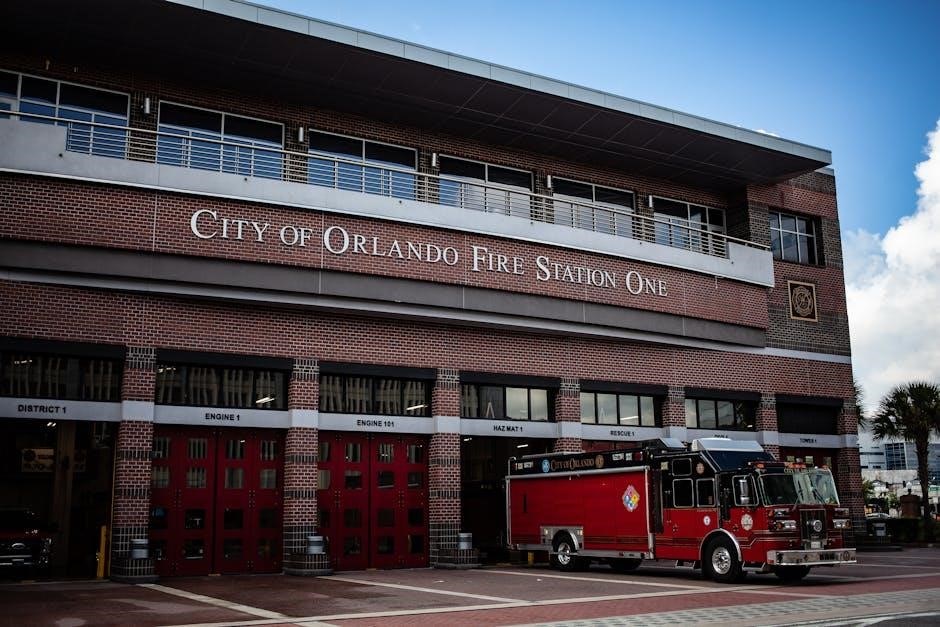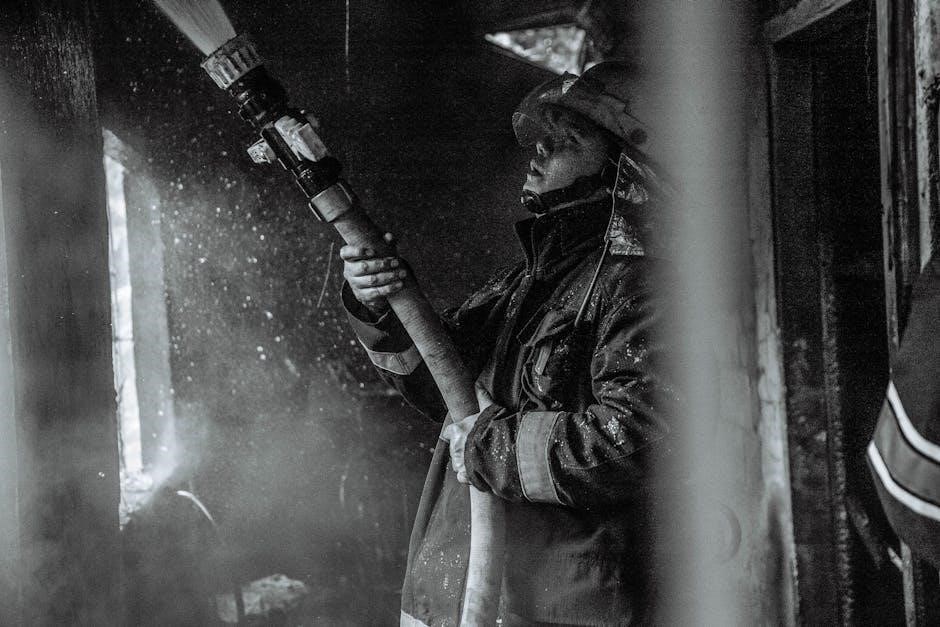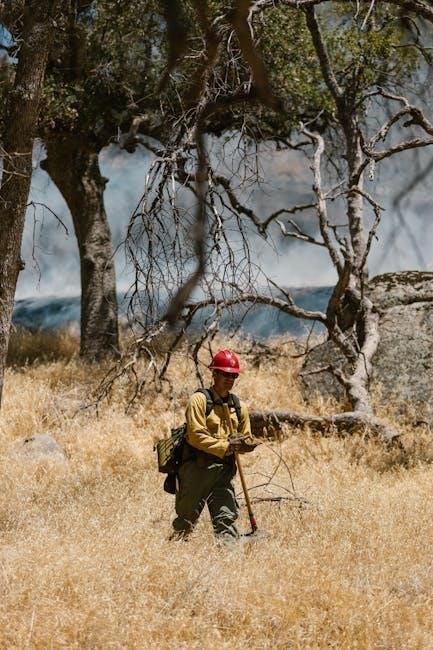NFPA 259 provides a standardized test method for determining the potential heat release of building materials under high-temperature conditions‚ crucial for fire safety assessments and compliance.
1.1. Overview of the Standard
NFPA 259 is a standardized test method for assessing the potential heat release of building materials under controlled high-temperature conditions. It provides a laboratory-based approach to evaluate how materials behave when exposed to fire‚ offering critical data for fire safety assessments. The standard is essential for understanding fire hazards and selecting materials that minimize risk in construction projects. Regular updates‚ such as the 2023 edition‚ ensure the standard remains aligned with advancing fire safety practices and technologies.
1.2. Purpose and Scope of NFPA 259
NFPA 259’s purpose is to provide a standardized test method for determining the potential heat release of building materials under high-temperature exposure. Its scope includes laboratory testing protocols to assess material behavior during fires‚ aiding in fire hazard evaluations. The standard helps identify materials that contribute less to fire intensity‚ supporting safer construction practices. It is designed for use by fire safety professionals‚ engineers‚ and regulatory bodies to ensure compliance with fire safety codes and standards.
1.3. Development and Publication by the National Fire Protection Association
NFPA 259 was developed by the Technical Committee on Fire Tests and published by the National Fire Protection Association (NFPA). The standard underwent rigorous review and consensus-based development‚ ensuring it reflects the latest advancements in fire safety science. First issued in 1998‚ it has been updated periodically‚ with the 2023 edition incorporating revisions to Annex B and reference documents‚ maintaining its relevance and accuracy in assessing material heat release under controlled conditions.
1.4. Relevance of the Standard in Fire Safety
NFPA 259 is critical for evaluating building material performance under fire conditions‚ aiding in fire hazard assessments and mitigation strategies. By measuring heat release‚ it helps predict fire growth and smoke spread‚ ensuring safer designs and compliance with fire safety codes. This standard is essential for architects‚ engineers‚ and safety professionals to make informed decisions‚ protecting lives and property from fire risks in various environments.

Key Features of NFPA 259
NFPA 259 provides a test method for measuring potential heat release of building materials under high-temperature conditions‚ updated in 2023 with revisions to Annex B and references.
2.1. Test Method for Potential Heat of Building Materials
NFPA 259 outlines a standardized test method to measure the potential heat release of building materials under controlled‚ high-temperature conditions. This method ensures accurate assessments of material behavior during fires‚ aiding in fire safety evaluations and compliance with safety standards. The test provides critical data for classifying materials based on their heat release characteristics‚ helping to mitigate fire hazards in various environments. Updates in the 2023 edition enhance accuracy and alignment with modern fire safety practices.
2.2. High-Temperature Exposure Conditions
NFPA 259 defines specific high-temperature exposure conditions to simulate real-world fire scenarios. These controlled laboratory settings help determine how building materials behave under extreme heat‚ ensuring accurate fire hazard assessments. The standard’s updated methodology in the 2023 edition reflects advancements in fire science‚ providing precise data on material performance during fires. This data is critical for predicting fire growth‚ smoke transport‚ and material degradation‚ aiding in the selection of safer construction materials and compliance with fire safety regulations.
2.3. Updates in the 2023 Edition
The 2023 edition of NFPA 259 introduces revised test procedures‚ enhanced data collection methods‚ and updated reference materials. It includes changes to Annex B‚ providing clearer guidance on interpreting test results. New guidelines address modern building materials and high-temperature scenarios‚ ensuring the standard remains aligned with current fire safety research and practices. These updates enhance the accuracy and applicability of the test method‚ supporting better fire risk assessments and compliance with evolving safety standards.
2.4. Annex B and Reference Document Updates
The 2023 edition of NFPA 259 includes significant updates to Annex B‚ offering detailed explanations of test methodologies and data interpretation. Reference documents have been expanded to incorporate recent research findings and industry practices. These updates ensure that Annex B aligns with current fire safety standards‚ providing users with comprehensive guidance for conducting accurate and reliable tests. The revised annex enhances the usability of the standard‚ facilitating better understanding and application of the test method by professionals.

Fire Safety Applications of NFPA 259
NFPA 259 ensures fire safety by guiding material selection‚ compliance‚ and risk assessment‚ protecting lives and property from potential fire hazards in various environments.
3.1. Protecting Lives and Property from Fire Hazards
NFPA 259 ensures fire safety by evaluating building materials’ heat release‚ helping prevent rapid fire spread and reduce risks. This protects lives‚ property‚ and infrastructure from potential fires‚ ensuring safer environments in construction and design. By adhering to NFPA 259‚ professionals can make informed decisions on material selection and fire risk mitigation‚ ultimately safeguarding communities from fire-related disasters and economic losses.
3.2. Material Selection for Fire-Resistant Construction
NFPA 259 plays a crucial role in material selection for fire-resistant construction by providing standardized test methods to evaluate heat release rates of building materials. This enables architects and constructors to choose materials that minimize fire spread and intensity‚ ensuring compliance with fire safety codes. The standard’s data helps in selecting materials that can withstand high-temperature conditions‚ reducing fire-related risks and ensuring safer building designs. This informed selection process is vital for constructing fire-resistant and durable structures.
3.3. Compliance with Fire Safety Codes and Standards
NFPA 259 ensures compliance with fire safety codes by providing a standardized method to assess building materials’ heat release. This compliance is critical for meeting regulatory requirements and ensuring public safety. The standard’s updates‚ such as the 2023 edition‚ reflect evolving safety needs‚ making it essential for adherence. By following NFPA 259‚ professionals can verify material performance‚ align with fire safety codes‚ and maintain consistency across construction projects‚ thereby reducing fire risks and promoting a safer built environment.
3.4. Role in Building Design and Fire Risk Assessment
NFPA 259 plays a pivotal role in building design by providing critical data on material heat release‚ enabling architects and engineers to create safer structures. By assessing fire risk through standardized testing‚ it helps identify materials that minimize fire spread and smoke production. This data is integral to fire hazard analysis‚ informing design decisions that prioritize occupant safety and structural integrity. Incorporating NFPA 259 ensures buildings meet fire safety criteria‚ reducing potential risks and enhancing overall fire resilience.

How to Access NFPA 259
NFPA 259 can be accessed by downloading the PDF from the National Fire Protection Association’s website or through online platforms offering fire safety standards and resources.
4.1. Downloading the NFPA 259 PDF
The NFPA 259 PDF can be downloaded directly from the official National Fire Protection Association website. This document provides the standard test method for determining the potential heat of building materials under controlled laboratory conditions. The 2023 edition includes updates to Annex B and reference documents‚ ensuring compliance with the latest fire safety guidelines. Accessing the PDF is straightforward‚ and it serves as an essential resource for professionals involved in fire safety assessments and material testing.
4.2. Online Access to NFPA Standards and Technical Information
Online access to NFPA 259 and other standards is available through the National Fire Protection Association’s official website. This platform offers immediate downloads‚ multi-user access options‚ and customizable alerts for updates. The service is designed to be cost-effective and user-friendly‚ ensuring professionals have easy access to the latest fire safety guidelines and technical information. Regular updates and reference document changes are also accessible‚ supporting compliance with current standards and enhancing fire safety practices globally.
4.3. Multi-User Access and Cost-Effective Solutions
NFPA offers multi-user access solutions tailored for organizations‚ ensuring cost-effectiveness and flexibility. These solutions allow multiple users to access NFPA 259 and other standards simultaneously‚ optimizing resource utilization. Subscription models and bulk licensing provide affordable options for companies and institutions‚ making compliance with fire safety standards achievable without excessive costs. This approach supports scalable access‚ meeting the needs of both small teams and large enterprises while maintaining security and ease of use.
4.4. Free Public Access to NFPA Codes and Standards
NFPA provides free public access to its codes and standards‚ including NFPA 259‚ to promote fire safety awareness and compliance. This initiative ensures that everyone‚ from professionals to the general public‚ can access critical fire safety information without cost. NFPA’s commitment to public safety is reflected in its open-access policy‚ allowing individuals and organizations to download and utilize these resources freely‚ thereby enhancing community protection and adherence to safety guidelines globally.

Implementation and Compliance
Implementation of NFPA 259 requires adherence to its test methods and updates‚ ensuring materials meet fire safety standards through proper training and regular compliance checks.
5.1. Steps to Ensure Compliance with NFPA 259
To ensure compliance with NFPA 259‚ organizations must understand the standard’s requirements‚ conduct material tests under controlled conditions‚ and stay updated on the latest edition. Regular training for personnel and documentation of test results are essential. Compliance also involves verifying that materials meet the standard’s heat release criteria and maintaining records for audits. Adherence to these steps ensures fire safety and alignment with regulatory expectations.
5.2. Training and Professional Preparation for Firefighters and Rescuers
Firefighters and rescuers must undergo specialized training to understand NFPA 259’s implications on fire behavior and material response. This includes hands-on exercises‚ simulations‚ and theoretical knowledge of heat release rates. Training programs emphasize interpreting test data to predict fire spread and intensity‚ enabling informed decision-making during emergencies. Regular updates and refresher courses ensure professionals stay aligned with the latest standards and methodologies‚ enhancing their ability to protect lives and property effectively.
5.3. Regular Updates and Customizable Alerts
NFPA 259 offers regular updates to reflect advancements in fire safety and material testing. Customizable alerts notify users of revisions‚ ensuring compliance with the latest standards. These updates often include clarifications‚ new test methods‚ and expanded scope to address emerging materials. Staying informed through these updates is critical for fire safety professionals to maintain accurate knowledge and apply the standard effectively in real-world scenarios‚ enhancing overall fire protection strategies and outcomes.
5.4. Importance of Adhering to the Standard
Adhering to NFPA 259 ensures accurate measurement of potential heat release‚ critical for fire safety assessments. Compliance helps protect lives‚ property‚ and the environment by mitigating fire risks. It also supports legal requirements and industry best practices‚ ensuring materials meet safety standards. Proper adherence fosters confidence in fire-resistant designs and materials‚ ultimately contributing to a safer built environment and reducing potential economic losses from fire incidents.

The Role of the National Fire Protection Association
The National Fire Protection Association (NFPA) is a global leader in fire safety‚ developing standards like NFPA 259 to enhance public safety and prevent fire-related losses.
6.1. History and Mission of NFPA
Founded in 1896‚ the National Fire Protection Association (NFPA) is a nonprofit organization dedicated to eliminating death‚ injury‚ property loss‚ and economic loss due to fire and other hazards. Its mission focuses on advancing fire and life safety through research‚ training‚ and the development of consensus-based codes and standards. NFPA serves as a global leader‚ providing critical resources and education to professionals worldwide‚ ensuring public safety and fostering a culture of fire prevention and preparedness.
6.2. Global Impact of NFPA Standards
NFPA standards‚ including NFPA 259‚ have a profound global impact‚ shaping fire safety practices worldwide. Established in 1896‚ NFPA is a leader in developing codes and standards that protect lives and property. Its guidelines are widely adopted across industries‚ ensuring consistency and safety in commercial‚ industrial‚ and residential environments. NFPA’s resources and training programs are accessed globally‚ fostering collaboration and advancing fire safety internationally. This global influence underscores NFPA’s commitment to public safety and loss prevention.
6.3. Commitment to Public Safety and Loss Prevention
NFPA’s unwavering commitment to public safety and loss prevention drives the development of standards like NFPA 259. By providing evidence-based guidelines‚ NFPA aims to reduce fire-related risks and protect lives‚ property‚ and the environment. Its work extends beyond the U.S.‚ offering free access to codes and training‚ ensuring everyone can adopt best practices. This dedication fosters a safer global community‚ aligning with NFPA’s mission to eliminate preventable injuries and economic losses due to fire and other hazards.
6.4. Collaboration with Other Safety Organizations
NFPA actively collaborates with global safety organizations to advance fire safety standards and practices. These partnerships facilitate the sharing of resources‚ research‚ and expertise‚ ensuring the development of cohesive safety protocols. By working together‚ NFPA enhances the global adoption of its standards‚ including NFPA 259‚ to protect lives‚ property‚ and the environment. This collaborative approach strengthens the organization’s mission to create a safer world through standardized fire safety solutions.

Technical Details of NFPA 259
NFPA 259 outlines laboratory testing of building materials under controlled conditions to measure potential heat release‚ ensuring accurate fire safety assessments and compliance with updated standards.
7.1. Laboratory Conditions for Testing
NFPA 259 specifies controlled laboratory conditions for testing building materials‚ including precise temperature regulation and high-temperature exposure settings. The test furnace maintains uniform heat distribution‚ ensuring consistent results. Thermocouples and heat flux measurements are used to monitor conditions accurately. These controlled environments simulate real-world fire scenarios‚ enabling precise evaluation of material behavior under extreme heat. Proper calibration and equipment maintenance are emphasized to guarantee reliable and repeatable test outcomes‚ ensuring accurate fire safety assessments and material performance evaluations.
7.2. Measurement of Potential Heat Release
NFPA 259 outlines methods to measure the potential heat release of building materials under controlled conditions. Heat flux‚ mass loss‚ and oxygen consumption are monitored to calculate heat release rates. Thermocouples and oxygen analyzers record data throughout the test. The test furnace maintains precise temperatures‚ ensuring accurate measurements. Data is collected over time‚ providing a detailed heat release profile. These measurements help assess material performance in fire scenarios‚ aiding in fire safety evaluations and material selection for safer buildings. Regular calibration ensures reliable results. Updates in the 2023 edition enhance measurement precision and accuracy.
7.3. Classification of Building Materials Based on Heat Release
NFPA 259 classifies building materials based on their potential heat release during high-temperature exposure. Materials are categorized by their heat release rate (HRR) and total heat released. This classification helps assess fire hazard potential and informs material selection for fire-resistant construction. The standard provides clear criteria for different classes‚ ensuring consistency in evaluating material performance. These classifications are essential for compliance with fire safety codes and standards‚ supporting safer building design and fire risk mitigation‚ as outlined in the 2023 edition.
7.4. Interpretation of Test Results
The interpretation of test results from NFPA 259 involves analyzing the potential heat release rate and total heat released by building materials. These metrics determine how materials contribute to fire growth and hazard. Results are compared against safety criteria to assess fire risk and compliance with standards. Proper interpretation ensures accurate classification of materials‚ aiding in fire hazard assessment and decision-making for fire-resistant construction. This data is critical for ensuring compliance and enhancing fire safety in buildings‚ as outlined in the 2023 edition.

Fire Growth and Smoke Transport Modeling
Fire growth and smoke transport modeling analyze how fires develop and spread‚ using data from NFPA 259 to simulate realistic fire scenarios and improve safety measures.
8.1. Use of Models for Fire Safety Analysis
Fire growth and smoke transport models are essential tools for fire safety analysis‚ utilizing data from NFPA 259 to simulate realistic fire scenarios and predict behavior in various environments. These models help assess risks‚ design safer buildings‚ and optimize emergency response plans by integrating material heat release data with environmental factors. They are critical for understanding fire dynamics and ensuring compliance with safety standards‚ enabling professionals to make informed decisions to protect lives and property effectively.
8.2. NFPA 259 in Fire Growth Modeling
NFPA 259 plays a crucial role in fire growth modeling by providing precise data on the potential heat release of building materials. This data is integrated into fire simulation tools to predict fire behavior‚ spread‚ and intensity. By aligning with NFPA 259‚ models can accurately simulate real-world fire scenarios‚ enabling better design of fire-resistant structures and emergency response strategies. This integration ensures that fire safety analyses are both reliable and actionable‚ contributing to enhanced public safety and property protection.
8.3. Integration with Other NFPA Standards
NFPA 259 seamlessly integrates with other NFPA standards‚ ensuring a comprehensive approach to fire safety. By aligning with documents like NFPA 87 and 92‚ it provides a cohesive framework for fire testing‚ modeling‚ and safety practices. This integration enables consistent application of fire protection principles‚ enhancing the reliability of fire risk assessments and promoting adherence to global safety benchmarks. Such collaboration underscores NFPA’s commitment to creating unified solutions for modern fire safety challenges.
8.4. Advances in Fire Simulation Technology
Advances in fire simulation technology have significantly enhanced the application of NFPA 259‚ enabling more accurate predictions of fire behavior. Modern computational models incorporate NFPA 259 data to simulate heat release rates and smoke propagation in various scenarios. These tools are invaluable for designing safer buildings and training firefighters. Continuous improvements in simulation software ensure that fire safety practices remain aligned with the latest scientific advancements‚ ultimately protecting lives and property more effectively.

Case Studies and Real-World Applications
NFPA 259 has been successfully applied in various construction projects‚ enhancing fire safety in high-risk environments. Historical fire incidents have validated its effectiveness in modern fire safety practices.
9.1. Successful Implementation of NFPA 259 in Construction Projects
NFPA 259 has been instrumental in ensuring fire safety in construction projects by providing standardized testing for building materials. Its implementation has led to the selection of fire-resistant materials‚ reducing fire hazards. Compliance with NFPA 259 has been documented in various case studies‚ showcasing its effectiveness in real-world applications. The standard’s test method for potential heat release has proven critical in assessing material performance under high-temperature conditions‚ ensuring safer building environments. This has contributed significantly to protecting lives and property in the built environment.
9.2. Impact on Fire Safety in High-Risk Environments
NFPA 259 significantly enhances fire safety in high-risk environments by providing critical data on material heat release. Its standardized testing ensures materials used in hazardous settings meet rigorous safety criteria‚ reducing ignition risks. This is particularly vital in industries like manufacturing and high-rise construction‚ where fire hazards are elevated. By adhering to NFPA 259‚ stakeholders can mitigate potential fire disasters‚ ensuring the safety of both people and infrastructure in high-risk areas.
9.3. Lessons Learned from Historical Fire Incidents
Historical fire incidents have underscored the importance of NFPA 259 in improving fire safety. By analyzing past tragedies‚ the standard has evolved to address material failures and ignition risks. For instance‚ incidents involving rapid fire spread in high-rise buildings highlighted the need for accurate heat release data. NFPA 259 now provides critical insights‚ enabling safer material selection and informing fire prevention strategies. These lessons continue to shape updates in the standard‚ ensuring it remains a vital tool in mitigating fire hazards and protecting lives.
9.4. Role of NFPA 259 in Modern Fire Safety Practices
NFPA 259 plays a pivotal role in modern fire safety by providing a reliable method to assess building materials’ heat release. Its data informs fire risk assessments‚ material selection‚ and code compliance. This standard supports fire growth modeling and smoke transport analysis‚ enhancing the design of safer buildings. By integrating with other NFPA standards‚ it ensures a comprehensive approach to fire safety‚ aiding architects‚ engineers‚ and safety professionals in creating resilient structures that protect occupants and property from fire hazards effectively.

Challenges and Future Directions
NFPA 259 faces challenges in material testing complexity and global standardization. Future updates aim to enhance test methods‚ integrate new technologies‚ and expand international adoption for improved fire safety.
10.1. Emerging Trends in Fire Safety Standards
Emerging trends in fire safety standards focus on advancing material testing‚ integrating new technologies‚ and harmonizing global fire safety practices. NFPA 259 aligns with these trends by incorporating updates that reflect modern fire hazards and innovative testing methods. The standard adapts to evolving risks‚ such as high-rise fires and complex materials‚ ensuring it remains a cornerstone for fire safety. These advancements aim to enhance accuracy‚ efficiency‚ and applicability in diverse environments‚ fostering safer buildings and communities worldwide.
10.2. Challenges in Material Testing and Compliance
Material testing under NFPA 259 presents challenges‚ including complex laboratory setups and interpreting heat release data. Compliance requires precise equipment and skilled personnel‚ which can be resource-intensive for organizations. Additionally‚ variability in material composition and high-temperature exposure conditions can affect test reproducibility. These challenges highlight the need for standardized protocols and ongoing training to ensure accurate and reliable results‚ maintaining the integrity of fire safety standards and protecting lives and property effectively.
10.3. Future Updates and Revisions to NFPA 259
Future updates to NFPA 259 will focus on advancing test methodologies and incorporating new technologies for fire safety. Revisions may include enhanced protocols for high-temperature exposure and improved data interpretation. The standard will likely address emerging materials and construction techniques‚ ensuring alignment with global fire safety trends. Public reviews and expert panel feedback will guide these updates‚ maintaining NFPA 259’s relevance and effectiveness in protecting lives and property from fire hazards.
10.4. Global Adoption and Standardization Efforts
NFPA 259 is increasingly adopted globally‚ fostering standardized fire safety practices. The National Fire Protection Association collaborates with international bodies to promote its implementation‚ ensuring consistency in material testing and fire risk assessment. Translations and regional adaptations facilitate wider acceptance‚ aiding in the harmonization of fire safety standards worldwide. This global effort enhances fire safety measures‚ reducing risks and protecting lives and property across diverse regions and industries.
